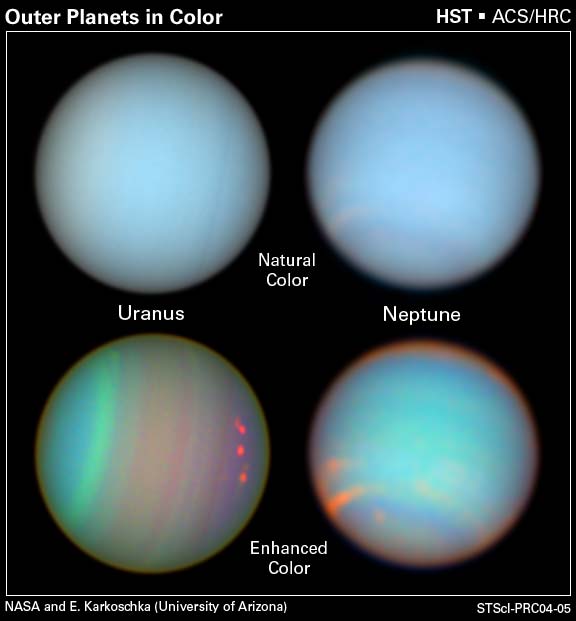
Having successfully completed its primary science objective of exploring the systems of the giant planets Jupiter and Saturn in 1979 and 1981 respectively, NASA’s iconic Voyager 2 spacecraft began a new chapter in its mission by continuing on its epic journey to venture into the realm of the enigmatic ice giants in the outer Solar System. Almost a decade after being launched in 1977, the intrepid robotic explorer provided humanity with its first close-up views of Uranus in January 1986 and Neptune in August 1989, triumphantly concluding its historic Planetary Grand Tour of the outer Solar System. Yet, even though Voyager 2 provided planetary scientists with a treasure trove of new knowledge allowing them to answer many questions about these mysterious ice worlds, it nevertheless raised an equal number of new questions. For years, the bulk of our understanding of Uranus and Neptune was mostly based on the data that had been collected by these brief flybys. All this changed in April 1990, when the launch of the Hubble Space Telescope opened a whole new window to the Universe. Ever since, the legendary orbiting observatory has helped astronomers and planetary scientists alike to shed a completely new light on these distant worlds, while also helping to truly revolutionise our view of the dark reaches of the outer Solar System along the way.
The Fascinating Ice Giants
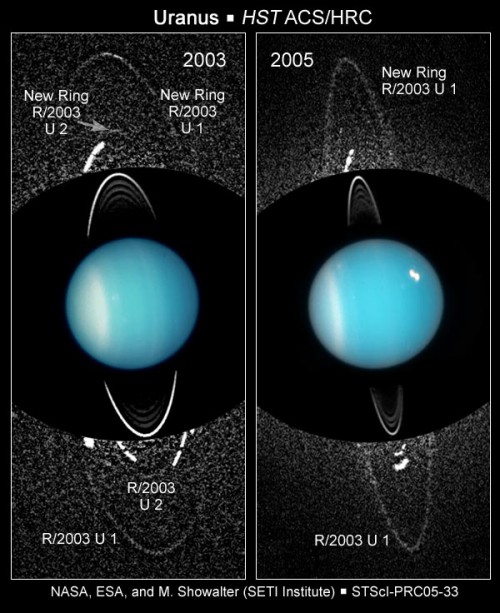
Uranus is certainly a unique member of the Sun’s planetary family. The distant world is famous for being the only planet in the Solar System with a rotational axis that is almost parallel to the plane of the ecliptic. Where the axis of all the other major planets are more or less perpendicular than 30 to the ecliptic plane, Uranus’ axial tilt of 97.7 degrees means that the planet is essentially “rolling” on its side during its 84-year-long journey around the Sun. That alone made the mysterious ice giant an exciting target of study. Yet, when Voyager started beaming back its first close-up pictures of the planet, planetary scientists were treated to the disappointing view of a featureless cyan-green-tinted disk. Apart from a scarce number of visible small clouds, Uranus’ face appeared mostly bland to Voyager’s electronic eyes, ultimately giving rise to the definition of the ice giant as the “boring” planet. The reason for this lack of atmospheric features in Voyager’s images was the design of the spacecraft itself, whose onboard imaging science system was capable of observing the planet only in visible and ultraviolet light, while lacking the ability to observe Uranus in infrared wavelengths, where its atmospheric features would subsequently turn out to be readily apparent.
The latter finally became available with the launch of the Hubble Space Telescope. Throughout the 1990s and 2000s, the orbiting observatory studied the planet extensively, revealing an atmosphere that was much more dynamic than previously thought. While the planet was approaching its vernal equinox in December 2007, its atmosphere started to undergo significant seasonal changes. Hubble’s superior observing capabilities in infrared wavelengths helped to reveal a planet with an ever-changing atmosphere, not unlike that of the other gas giant planets in our Solar System. Astronomers discovered changing bright clouds and banded structures that were invisible to Voyager 2′s instruments. A year before the 2007 equinox, Hubble also detected a large elongated dark vortex on Uranus for the first time, similar to Neptune’s trademark Great Dark Spot that had been observed by Voyager 2, albeit much smaller in size. It became clear that as the planet was approaching equinox, the mid and equatorial regions that were previously covered in darkness were responding to the increased warmth of the Sun, showcasing an interesting and volatile atmosphere, worthy of a more detailed, close-up study.
By utilising Hubble, astronomers were further able to discover a new set of extremely faint rings and small moonlets orbiting the planet, which had gone unnoticed during the Voyager 2 flyby. These observations indicated that these moonlets, which were no more than a dozen miles wide, must be sandblasted by continuous micrometeorite impacts, which in turn eject fresh dark material into space that is subsequently caught by Uranus’ massive gravity, forming the faint rings that were spotted with the Hubble Space Telescope. Furthermore, Hubble was also able to make the first Earth-based observations of Uranus’ faint and short-lived auroras, giving scientists a glimpse into the planet’s largely enigmatic magnetosphere, which is quite unlike those around other planets in the Solar System. “It’s a testament to how much our Earth-based instruments have improved in 20 plus years that we can now see such faint objects 1.7 billion miles away,” says Mark Showalter, a Senior Research Scientist at the SETI Institute in Mountain View, Calif., who has been studying the atmospheres and ring systems of the outer planets for decades.
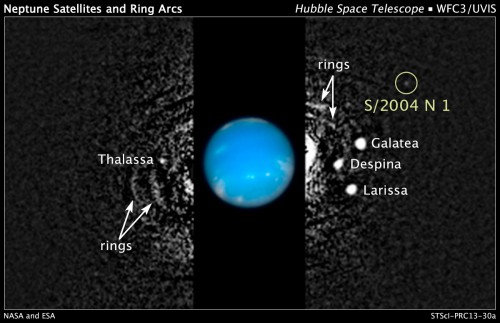
Farther out from the Sun, beyond Uranus, lies the similar-sized ice giant Neptune. Contrary to its planetary sibling, Neptune displayed an easily visible, lively, and dynamic atmosphere and weather patterns to the electronic eyes of Voyager when the latter passed by the planet in 1989, largely due to the fact that Neptune radiates into space more than two times the energy it receives from the Sun. This internal heating is also believed to be the driver for the planet’s ultra-fast winds, which can easily top at near-supersonic speeds, making them the fastest atmospheric winds in the entire Solar System.
An atmospheric feature that really stood out in the Voyager images was the Great Dark Spot, a colossal Earth-sized storm that raged on the planet’s southern hemisphere. Yet observations with the Hubble Space Telescope several years later revealed that the Great Dark Spot had disappeared completely, only to be replaced by a similar, albeit smaller, one at northern latitudes that was accompanied by a series of bright, high-altitude clouds, leaving astronomers perplexed as to the exact mechanisms behind their formation. “They behave like storms, and the Great Dark Spot was an exaggerated features we haven’t seen on any other planet,” comments Lawrence Sromovsky, a planetary scientist at the University of Wisconsin–Madison. “They seem to come and go, and rather than an exciting development of these dark spots, they dissipate.” Atmospheric dynamics aside, Hubble’s keen vision in more recent years was able to spot an inconspicuous, tiny moonlet no more than 12 miles across, bringing Neptune’s current total tally of natural satellites to 14. The fact that Hubble was able to detect such tiny objects at all at a distance of more than 3 billion miles away really speaks volumes about the orbiting observatory’s superior abilities.
The Distant Reaches of the Kuiper Belt
One of the great revelations of modern astronomical research was the discovery of a vast expanse of possibly up to hundreds of thousands of icy planetesimals beyond the orbit of Neptune in the early 1990s. The existence of this new area, called the Kuiper Belt, completely changed our view of the Solar System. Where the latter was previously thought to be a tidy, well-organised place, consisting of a family of terrestrial planets, gas giants, and the oddball Pluto thrown in for good measure, it suddenly changed into a place were major planets became the minority and the Kuiper Belt objects were now the dominant population of planetary bodies. More importantly, a new realisation gradually dawned that Pluto itself was in fact one of the largest members of this population of icy minor bodies. This came about after a series of historic discoveries during the early 2000s of icy bodies in the outer reaches of the Solar System, some of which were even larger than Pluto.
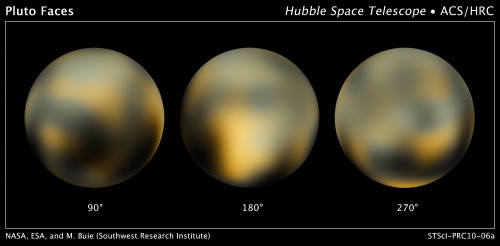
The Hubble Space Telescope was central in these discoveries, by detecting several Kuiper Belt of a substantial size, while also helping astronomers to determine the exact size of Eris, a dwarf planet first discovered in 2005 and, due to its size, was originally thought of as the long-sought-for 10th planet. Subsequent observations with Hubble revealed that, even though Eris wasn’t as big as originally suggested, it was still bigger than Pluto. This realisation, along with the fact that astronomers kept finding objects that had a size similar to Pluto’s, started a heated debate within the scientific community concerning the definition of “planet” and whether Pluto itself should be considered as such. This debate, which rages on to this day, eventually led the International Astronomical Union to adopt a controversial definition of planethood in 2006, which reclassified Pluto as a “dwarf planet,” reducing the number of major planets in the Solar System to eight. “Pluto had it coming,” Neil deGrasse Tyson and Mike Brown would later jokingly comment on the subject, both world-renowned astronomers. Others wouldn’t share the sentiment. “We used to think of the Solar System as the four terrestrial planets, the four giant planets, and misfit Pluto,” says Dr. Alan Stern, principal investigator for NASA’s New Horizons mission (which is scheduled to conduct humanity’s first ever close fly by of the Pluto system this July), commenting on the prevalence of the Kuiper Belt Objects in the outer Solar System. “Who’s the misfit now?”
Proving its indispensable worth to the astronomy community once more, the Hubble Space Telescope has played an integral role in the overall design of the New Horizons mission’s final approach to the dwarf planet. Having already discovered in the last couple of years Pluto’s four smaller moons—Nix, Hydra, Kerberos, and Styx—which allowed mission planners to fine-tune New Horizons’ trajectory through the Pluto system, Hubble undertook an extensive observing campaign in 2014 in order to search for suitable Kuiper Belt Objects beyond the orbit of Pluto which the spacecraft could visit in the following years. Confirming the hopes of the mission’s team, the orbiting observatory was able to spot three such objects of interest that lie in the spacecraft’s path, thus helping to save New Horizons’ extended mission beyond Pluto. “This has been a very challenging search and it’s great that in the end Hubble could accomplish a detection – one NASA mission helping another,” Stern would say jubilantly following Hubble’s discoveries.
These latest findings by the Hubble Space Telescope further underscore one of the observatory’s lasting legacies. Having already performed beyond expectations in all areas of astronomical research, Hubble has also been instrumental in paving the way for humanity’s upcoming historic exploration of the vast, distant reaches of the Kuiper Belt.
You can read Part 3, here.
Below are more images and videos of Uranus, Neptune and various Kuiper Belt Objects by the Hubble Space Telescope:
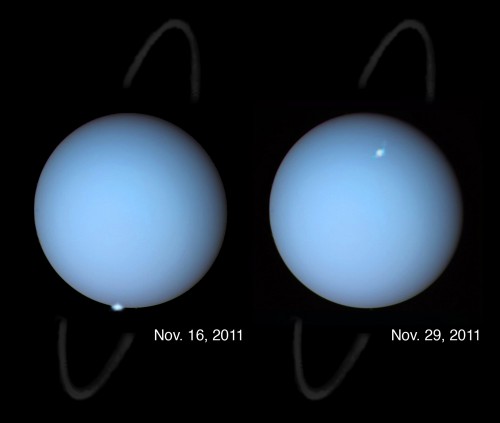
A dramatic time-lapse movie of Uranus by the Hubble telescope showing the planet’s seasonal changes.
Video Credit: Karkoschka, Hammel, et. al.
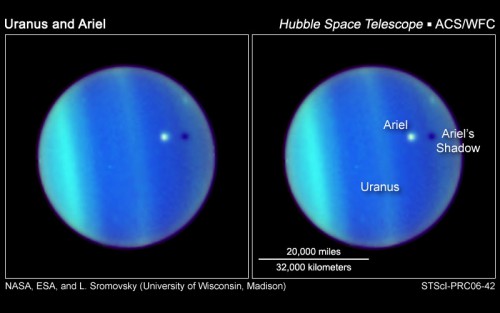
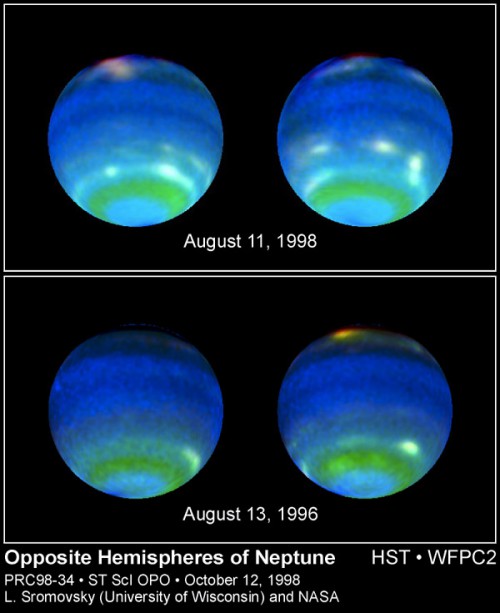
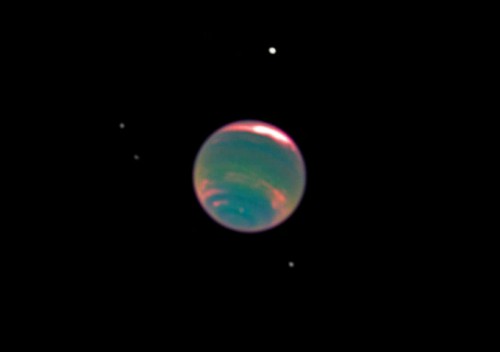
A video sequence of Hubble’s observations of Neptune and four of its moons.
Video Credit: The Hubble Heritage Team (STScI/AURA) and A. Simon-Miller (NASA/GSFC)
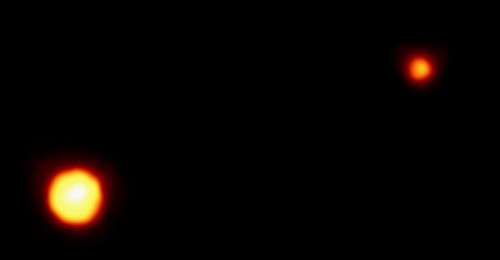

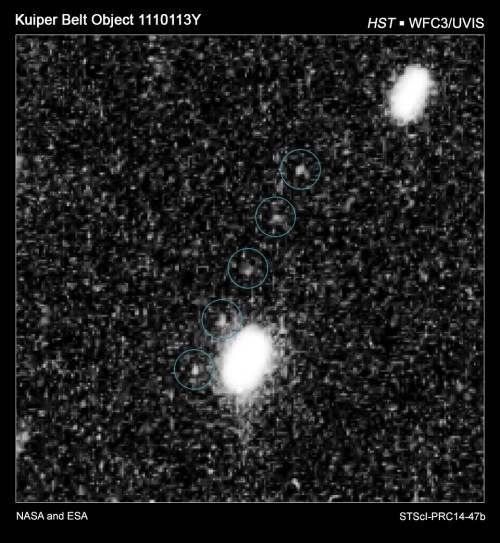
Want to keep up-to-date with all things space? Be sure to “Like” AmericaSpace on Facebook and follow us on Twitter: @AmericaSpace




Thanks Leonidas,
I am fascinated by the outer solar system- Triton is my favorite moon. I would love to visit it some day. It could happen. Never say never.
I am curious about any estimates of how much water there is in the icy bodies of the Kuiper belt and Oort cloud. Being a follower of Gerard K. O’Neill I am always thinking about just how many people and how many of those hollow artificial moons- Bernal Spheres- the resources of the solar system could maintain and I imagine that would largely depend on the water available. I read 80 billion people somewhere.
Since these mega-habitats could be pushed by H-bombs to some percentage of the speed of light it is an awe-inspiring possibility that in the next century hundreds of millions of cryopreserved people could leave this solar system on voyages to other stars.
Neptune is my favorite planet and I’m fascinated by Triton as well – possibly has to do with the large impression that the Voyager 2 flyby had on me when I was little. As to the total amount of water that might be present in the Kuiper Belt, there can’t be any firm estimates as of date. It is thought that there may be 2-3 trillion comets in total, lying around in the Kuiper Belt, but analysis of their composition is really difficult – they are too far away and too dim to be studied in detail from Earth and we haven’t studied too many of them anyway. Several studies in recent years have examined a small population of several dozens of them and have found definite traces of water ice, but the uncertainties are large enough that any estimates could differ by more than an order of magnitude.
Hopefully, the New Horizons mission will be able to provide us with some much-needed data on the subject. Also, if you’re interested, there is a relevant study here by M. Brown et al. where you can read more details…
Well, there was a paper published in 1983 (P.R. Weissman, “The mass of the Oort cloud”, Astronomy and Astrophysics, vol. 118, no. 1, Feb. 1983, p. 90-94.) that estimated the Oort cloud to have a mass of 1.9 time that of the Earth, give or take an order of magnitude. If we assume that the bodies in the Oort cloud contain about half ice, half rock/metal, then there is something like 0.1 to 10 Earth-masses of water in the Oort cloud.
As for the Kuiper Belt, there have been a variety estimates made but one published in 2001 (Brett Gladman et al., “The Structure of the Kuiper Belt: Size Distribution and Radial Extent”, The Astronomical Journal, Volume 122, Issue 2, pp. 1051-1066, Aug 2001) estimates a mass “on the order of 0.1” times that of the Earth between 30 and 50 AU. Again, assuming a half and half mixture of ice, that’s an ice mass on the order of 0.05 times the mass of the Earth (around four times the mass of the Moon).
Although there is less ice in the Kuiper Belt than in the Oort cloud by maybe an order of magnitude or more, the Kuiper Belt is smaller and closer making it easier to exploit. Easier still and with comparable amounts of ice would be the icy moons of the gas giants from Jupiter to Neptune). Closer still (but with no where near the total mass of water) would be the asteroids.
Thanks for the detailed explanation Andrew!
Hi there! I could have sworn I’ve been to this site before but after looking at some of the articles I realized it’s new to me.
Regardless, I’m definitely happy I stumbled upon it and I’ll
be book-marking it and checking back frequently!